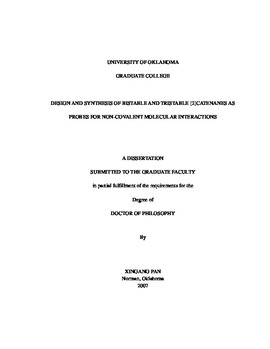| dc.contributor.advisor | Halterman, Ronald L., | en_US |
| dc.contributor.author | Pan, Xingang. | en_US |
| dc.date.accessioned | 2013-08-16T12:20:53Z | |
| dc.date.available | 2013-08-16T12:20:53Z | |
| dc.date.issued | 2007 | en_US |
| dc.identifier.uri | https://hdl.handle.net/11244/1247 | |
| dc.description.abstract | With wider bis(p-benzyl)methyl spacers in 4,4'-dipyridinium macrocycles interlocked with the BPP34C10, four symmetric [2]catenanes have been studied. Symmetric blocking groups on tethers enabled either pathway for circumrotation of the BPP34C10 between isoenergetic sites to be blocked. We also found that it is possible to lower the energy barriers for circumrotation of the BPP34C10 along wider tethers. The energy barriers required for passage over the unblocked, wider rigid tethers were about 11.5 kcal/mol. According to the chemical shifts of the BPP34C10, its internal hydroquinone ring could pi-pi-stack with only one 4,4'-dipyridinium binding site at a time. This study demonstrated an ability to select the pathway in these [2]catenanes containing the rigid bis(p-benzyl)methyl tether and to lower the energy barrier for interconversion through destabilization of the ground state structures. | en_US |
| dc.description.abstract | Tristable catenanes with three identical binding sites were designed for a unidirectional molecular motor. Interlocked with the BPP34C10, a ring with three 4,4'-dipyridinium sites was designed to be tethered by three identical 3-(2-ethyl)-1-methylphenyl tethers. 4-Methylbenzyl or 4-isopropylbenzyl groups were installed on the phenyl groups to provide conformationally mobile gates. Most of synthesis of this system has been accomplished except the last step. | en_US |
| dc.description.abstract | Making unidirectional molecular motors is a very inspiring topic for scientists since control of molecule-level movements is difficult and rewarding. Unidirectional molecular motors driven by photochemical, chemical with thermal energy were successfully achieved. However, no purely thermally driven molecular motors have been reported since they could violate the well-established theory. In our study, we hoped to utilize random thermal fluctuation to drive unidirectional motion through a thermally-driven modulation of the translational energy potential. Our studies were based on the movements of a interlocked system---[2]catenanes. These catenanes consisted of two interlocked parts: a dibenzo-34-crown-10 ether (BPP34C10) and macrocycle rings containing 4, 4'-dipyridiniums tethered by aryl spacers. | en_US |
| dc.description.abstract | The conformational interconversions of six [2]catenanes containing a dibenzo-34-crown-10 ether (BPP34C10) interlocked with rings containing two 4,4'-dipyridiniums tethered by 1,3-bis(ethyloxy)phenyl and 1,3-xylyl or 1,4-xylyl spacers have been studied. In these symmetric catenanes, we were able to control the path selection of one ring around another macrocycle with blocked or unblocked tethers. The free energy of activation for passing along the unblocked tethers ranged from 11 to 13 kcal/mol. The 1:1 ratio of two isomers at low temperature indicated that two binding sites are isoenergetic. We demonstrated an ability to control the movements of one ring around another ring along different pathways with different energy barriers in interlocked systems. | en_US |
| dc.description.abstract | [2]Catenanes containing the BPP34C10 interlocked with rings of two 4,4 '-dipyridiniums tethered by two phenyl rings conjugated with an enone have been studied. The unsymmetric gates, 4-methylphenyl, 4-n-butylphenyl, 4-isopropylphenyl, 4-biphenyl, were appended in the enone system to modulate energy barriers to drive a preferential circumrotation of the BPP34C10. However, according to their 1H NMR and 2D-EXSY spectra, the 1:1 ratio of two isomers indicated no biasing gate effect as designed. This ratio indicated equal energy of two ground states of 4,4'-dipyridinium binding sites in these catenanes. We demonstrate that the ground states of two binding sites are not affected by unsymmetric gates in the catenanes with rigid tethers. | en_US |
| dc.description.abstract | Through these studies, we demonstrated an ability to control the path selection along different pathways with blocked and unblocked tethers in the interlocked system-[2]catenanes. With wider tethers, we were able to lower the energy barriers by destabilization of the ground state structures. In the catenanes with rigid ethers, we demonstrated an ability to control equal or close energy barriers of two ground states even with unsymmetric gates. No bias for unidirectional motion was observed. | en_US |
| dc.format.extent | x, 299 leaves : | en_US |
| dc.subject | Molecular dynamics. | en_US |
| dc.subject | Catenanes. | en_US |
| dc.subject | Molecular biology. | en_US |
| dc.subject | Chemistry, Organic. | en_US |
| dc.title | Design and synthesis of bistable and tristable [2]catenanes as probes for non-covalent molecular interactions. | en_US |
| dc.type | Thesis | en_US |
| dc.thesis.degree | Ph.D. | en_US |
| dc.thesis.degreeDiscipline | Department of Chemistry and Biochemistry | en_US |
| dc.note | Adviser: Ronald L. Halterman. | en_US |
| dc.note | Source: Dissertation Abstracts International, Volume: 68-07, Section: B, page: 4492. | en_US |
| ou.identifier | (UMI)AAI3273883 | en_US |
| ou.group | College of Arts and Sciences::Department of Chemistry and Biochemistry | |
